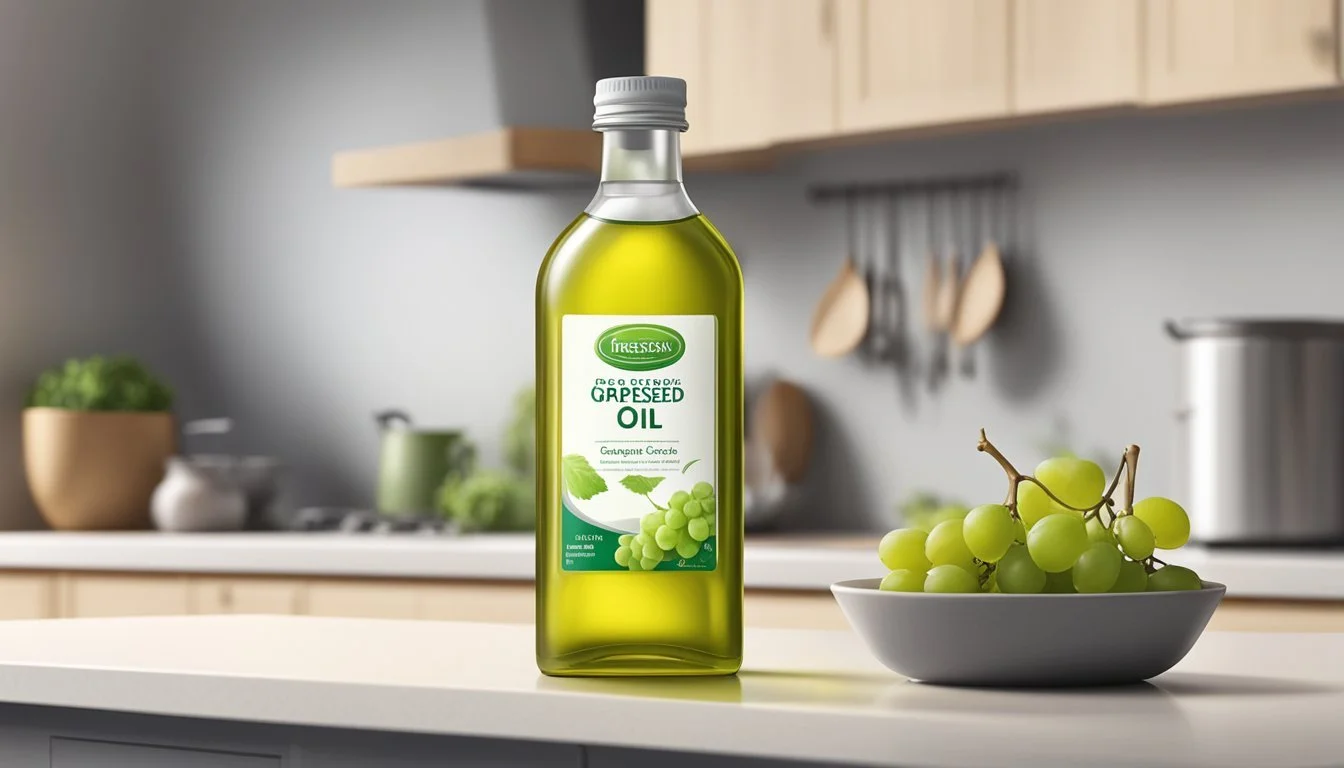Does Grapeseed Oil Go Bad?
Understanding Shelf Life and Spoilage Signs
Grapeseed oil, a byproduct of winemaking, is a cooking oil favored for its light flavor and high smoke point, making it a versatile choice for frying, sautéing, and baking. Like all oils, it isn't impervious to spoilage. The longevity of grapeseed oil depends on storage conditions and whether the bottle has been opened. When stored properly in a cool, dark place, an unopened bottle of grapeseed oil can typically last for up to 24 months. Once opened, the exposure to oxygen, light, and heat can accelerate the rancidification process, shortening its shelf life.
To maintain its quality, users should ensure the oil is tightly sealed and stored away from direct sunlight to prevent oxidation. Warning signs of spoilage include an off smell, bitter taste, or any visible mold. Fresh grapeseed oil should have a mild and neutral flavor; a deviation from this is a clear indication that the oil has gone bad. Consuming rancid oil can have adverse effects on health, therefore, it’s important to recognize these signs to avoid ingesting oil that is no longer suitable for consumption. Despite grapeseed oil being less susceptible to mold and bacterial growth due to its low moisture content, the risk of rancidity remains, driven by its fatty acid composition which can break down over time.
Understanding Grapeseed Oil
Grapeseed oil is a byproduct of the winemaking process, obtained from the seeds of grapes. It's known for its versatile uses in the kitchen and potential health benefits.
Composition and Nutritional Profile
Grapeseed oil is predominantly composed of polyunsaturated fats (70%), including a significant amount of omega-6 fatty acids. It also contains monounsaturated fats (around 16%) and a smaller proportion of saturated fat. Notably, grapeseed oil is also a source of vitamin E, an antioxidant that contributes to protecting cells from oxidative damage.
Nutrient Proportion Polyunsaturated fats Approximately 70% Monounsaturated fats Approximately 16% Saturated fat Lower concentration Vitamin E Present
Comparison with Other Cooking Oils
When compared with other oils like olive or soybean oil, grapeseed oil has a relatively higher content of polyunsaturated fats and vitamin E. The significant level of polyunsaturated fats, including omega-6 fatty acids, makes it different from oils higher in monounsaturated fats, such as olive oil. The omega-6 content is a point of consideration due to its abundance in the typical diet and its role in balancing omega-3 fatty acids.
Health Benefits
The antioxidants in grapeseed oil, particularly vitamin E, contribute to its health benefits. They help shield the body from free radical damage that can lead to various chronic diseases. The presence of healthy fats is associated with a reduced LDL (low-density lipoprotein) or "bad" cholesterol level, which may contribute to better cardiovascular health. However, the high omega-6 fatty acid content may require careful consumption to maintain a balanced dietary fat intake.
Grapeseed Oil Storage Fundamentals
Proper storage is essential to maintain the quality and extend the shelf life of grapeseed oil, with particular attention to temperature and light exposure.
Best Storage Practices
To preserve the freshness of grapeseed oil, it should be stored in a cool, dark place, away from direct sunlight and heat sources. Keeping the oil in an airtight container is also crucial to prevent oxidation, which can lead to rancidity.
Shelf Life of Unopened vs. Opened Bottles
The shelf life of grapeseed oil varies depending on whether the bottle is unopened or opened. An unopened bottle of grapeseed oil typically lasts 24 months from the date of production if stored correctly. Once opened, the oil should be used within 6 months for optimal quality.
Refrigeration and Room Temperature Storage
While storing at room temperature is acceptable, refrigeration can help extend the shelf life of grapeseed oil, especially once the bottle is opened. In the fridge, grapeseed oil can last up to one year. It is essential to ensure the oil is in a sealed container to thwart absorption of other food odors.
Freezing Grapeseed Oil
It is not generally recommended to freeze grapeseed oil; doing so can affect its consistency and quality. If one opts to freeze the oil, it must be in a sealed container to minimize exposure to air and moisture, and should be thawed at room temperature before use.
Preserving the Quality of Grapeseed Oil
To extend the shelf-life of grapeseed oil and maintain its quality, one must manage exposure to heat and light, prevent oxidation, and regularly assess the oil for freshness.
The Impact of Heat and Light
Heat and light can drastically reduce the quality of grapeseed oil. Refined grapeseed oil, with its high smoke point, is more resistant to heat, while cold-pressed variants are more prone to degradation. Store grapeseed oil away from direct sunlight and sources of heat to protect against oxidative stress and preserve its shelf-life.
Preventing Oxidation and Rancidity
Oxidation leads to rancidity, producing off-flavors and odors. To prevent this:
Minimize air exposure: Use airtight containers to limit contact with air.
Reduce light exposure: Store in dark-colored bottles.
Control temperature: Keep the oil in a cool environment, ideally below 70°F (21°C), to slow down the formation of free radicals.
Assessing Oil Freshness
Regularly checking grapeseed oil for signs of rancidity ensures consumption of a quality product. A rancid oil will often have a bitter taste and unpleasant smell, resembling nail polish remover or old paint. When noticing these signs, it is advisable to discard the oil to avoid the adverse effects of oxidative stress.
Identifying Spoilage in Grapeseed Oil
Grapeseed oil, like all oils, can deteriorate over time. Recognizing the signs of spoilage is integral to food safety and maintaining the quality of your dishes.
Spoilage Signs to Look For
Grapeseed oil is prone to spoilage, and one should be vigilant about checking for signs of degradation, particularly if the oil is nearing or has passed its expiration date. Visual indicators such as cloudiness or sediment, typically not present in fresh oil, can suggest spoilage. The presence of mold is a clear indicator that the oil should not be used.
Taste and Odor Indicators
The sensory properties of grapeseed oil are reliable measures of its condition. A fresh, high-quality grapeseed oil should have a clean, neutral taste and a light, pleasant scent. When the oil becomes rancid, it may develop a distinctly bitter or off taste and an unpleasant odor, resembling old paint or nail polish remover. These changes are due to oxidation and should serve as warning signs to discard the oil.
Risks of Using Spoiled Oil
Consuming spoiled or rancid grapeseed oil should be avoided as it can pose certain health risks, including digestive discomfort. Although not typically associated with severe foodborne illness, the use of rancid oils can lead to degradation in the nutritional quality of your food and potentially have negative impacts on overall health.
Utilizing Grapeseed Oil in Cooking
Grapeseed oil is appreciated for its versatility in the kitchen due to its high smoke point and mild taste. It has become a staple for various cooking methods and for adding a healthful touch to dressings and marinades.
Suitability for Various Cooking Techniques
Grapeseed oil's high smoke point, which exceeds 400 degrees Fahrenheit, makes it ideal for high-heat cooking methods like:
Frying: The oil can endure the required temperatures for deep-frying without smoking or breaking down.
Sautéing: Its neutral taste ensures that the flavor of the ingredients shines through.
Baking: Grapeseed oil can be a healthier alternative to butter or canola oil due to its content of polyunsaturated fats. In recipes, replace 1 cup of butter with ¾ cup of grapeseed oil to maintain a moist texture in cakes and muffins without altering the taste.
Grapeseed Oil in Dressings and Marinades
The subtle flavor profile of grapeseed oil doesn't overpower other ingredients, which is why it is often chosen for:
Salad Dressings: Its neutral taste allows the flavors of the herbs and vinegar to stand out.
Marinades: The oil serves as an excellent base for marinades for grilled meat and vegetables, as it helps to carry the flavors of added spices and seasonings.
Choosing the Right Oil for Your Dishes
When selecting cooking oils, one should consider several factors:
Taste Test: Although grapeseed oil is known for its neutral taste, it's recommended to conduct a taste test to ensure it complements the flavors of the dish being prepared.
Heat: Grapeseed oil is one of the more suitable options for high-heat cooking, unlike oils like olive oil, which may not fare as well at high temperatures.
Storage: Keep grapeseed oil in a cool, dark place in the pantry to preserve its quality. Proper storage is crucial to prevent the oil from turning rancid.
Incorporating grapeseed oil into cooking routines can enhance dishes while ensuring a better resistance to high temperatures.
Additional Uses and Benefits
Grapeseed oil provides a multitude of benefits, particularly in skin care and nutrition, due to its high antioxidant content and fatty acid composition.
Grapeseed Oil in Skin Care
Nutrition Profile: Grapeseed oil is lauded for its high content of vitamin E and omega-6 fatty acids, essential components that contribute to skin health. The oil's vitamin E acts as a powerful antioxidant that can help protect the skin from free radical damage and maintain its elasticity, which is crucial in the prevention of aging signs. Moreover, the linoleic acid, an omega-6 fatty acid found in grapeseed oil, plays a role in minimizing inflammation and may improve the skin’s barrier function.
Skin Hydration: Regular application of grapeseed oil has been associated with increased skin hydration.
Reduction in UV Damage: Its antioxidant properties may offer some defense against UV damage.
Heart Disease and Cholesterol Levels: Although not a direct benefit for skin care, it is worth noting that the same omega-6 fatty acids that benefit the skin can influence overall health. These fatty acids are known to affect cholesterol levels and may help in the prevention of heart disease when consumed in moderation as part of a balanced diet.
Alternatives to Grapeseed Oil
Nutritious Substitutes: When considering alternatives to grapeseed oil, it's important to look for options that provide a similar nutritious profile:
Olive Oil: Lower in omega-6 fatty acids, it's rich in monounsaturated fats, which are also conducive to heart health and can reduce inflammation.
Avocado Oil: Comparable in its vitamin E content, this oil also offers monounsaturated fats beneficial for skin and heart health.
Edible Alternatives: Edible alternatives such as coconut oil or butter might be favorably substituted in cooking for varied nutrition benefits, although they contain higher levels of saturated fat which should be consumed in limited amounts.
Specific Considerations:
Digestive Issues: Some individuals may find alternative oils easier to digest.
Trans Fat Content: It's essential to choose alternatives low in trans fats to mitigate the risk of heart disease and blood clots.
Employing different oils can diversify the fatty acid profile and antioxidants in one's diet, potentially offering broader health benefits and addressing specific dietary needs or restrictions.
Frequently Asked Questions
When it comes to the usage and storage of grapeseed oil, consumers often have a few common questions. This section aims to provide clear and concise answers based on typical user inquiries.
How Long Does Grapeseed Oil Last?
Unopened grapeseed oil typically has a shelf life of up to 24 months. Once opened, it is best used within 3 to 6 months. It should be noted that these time frames are general guidelines and the actual shelf life can vary depending on the storage conditions and oil quality.
Unopened: Up to 2 years
Opened: 3-6 months
How to Store Grapeseed Oil?
To maintain grapeseed oil's quality and extend its shelf life, store it in a cool and dark place such as a pantry. After opening, it's advisable to keep the bottle tightly sealed when not in use to protect it from oxidation. If stored properly, grapeseed oil can last up to 6 months in the pantry and up to 12 months in the refrigerator.
Pantry (After Opening): Up to 6 months
Refrigerator (Unopened / After Opening): Up to 12 months
Can You Freeze Grapeseed Oil?
While freezing grapeseed oil is possible, it is not recommended. Freezing can alter the oil's consistency and potentially its flavor. Instead, refrigeration is a suitable alternative for extending its life span without compromising the quality.








